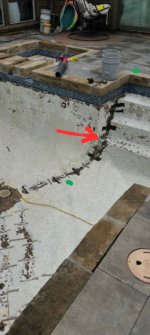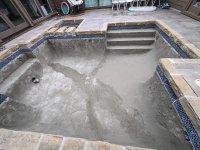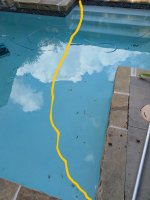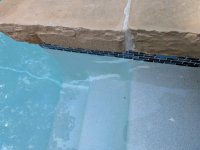Hi all!
My question is whether special cement or epoxy should be injected into the holes with the staples before they are covered by hydraulic cement. I saw this in a few videos of pool crack repairs.
I had my pool crack stapled and replastered within the last year. It was done with just rebar staples covered with hydraulic cement.
EDIT: The crack has returned, right along where the previously patched area and part of the crack repair was done. The crack runs from the bottom of the pool to the coping cement. Doing a dye test, it seems that the water is only leaking at a specific section of the crack. Compared to the photos they sent when the crack was stapled... it's leaking right where they didn't put a staple. Pool guys took a look and said it isn't covered due to the 'floor' moving.
I've stuck some putty in the crack for now while we figure out whats next.
Arrow showing leak location. Green dots show where the crack starts and ends. (not a full complete line) Also including the photo after they applied the scratch-kote.


I had my pool crack stapled and replastered within the last year. It was done with just rebar staples covered with hydraulic cement.
EDIT: The crack has returned, right along where the previously patched area and part of the crack repair was done. The crack runs from the bottom of the pool to the coping cement. Doing a dye test, it seems that the water is only leaking at a specific section of the crack. Compared to the photos they sent when the crack was stapled... it's leaking right where they didn't put a staple. Pool guys took a look and said it isn't covered due to the 'floor' moving.
I've stuck some putty in the crack for now while we figure out whats next.
Arrow showing leak location. Green dots show where the crack starts and ends. (not a full complete line) Also including the photo after they applied the scratch-kote.


Last edited:







